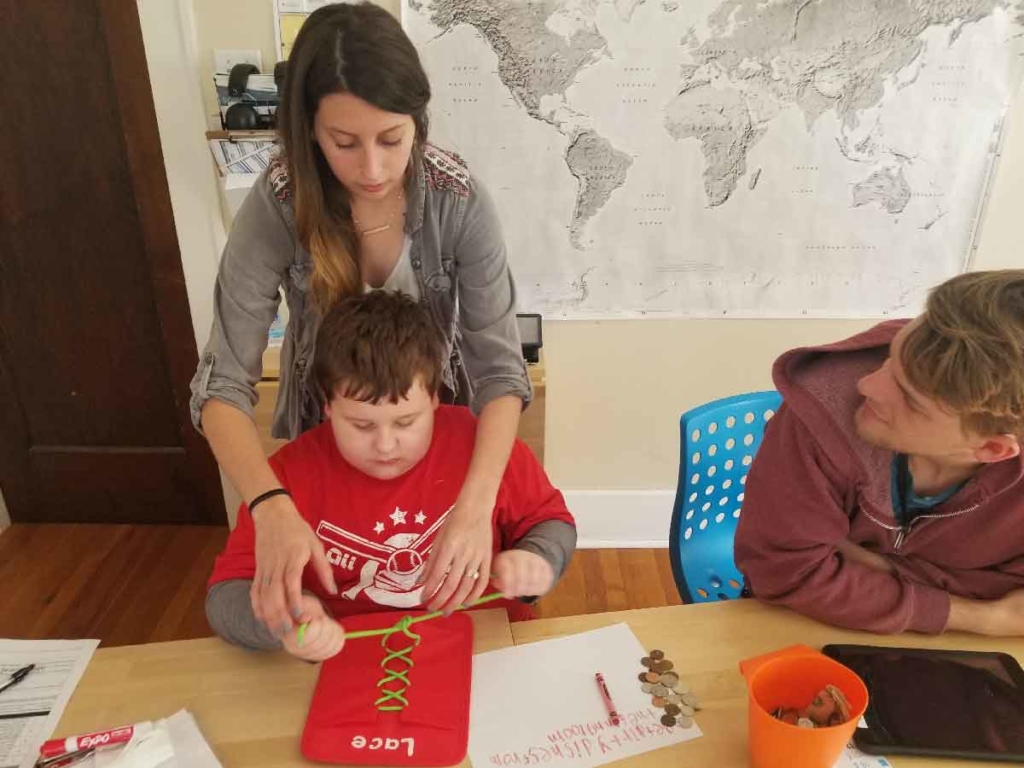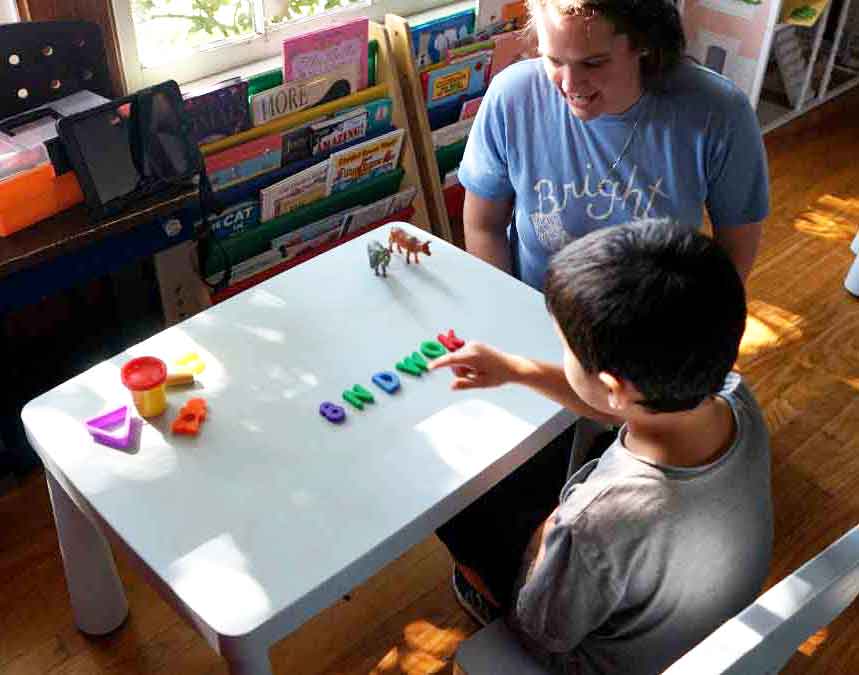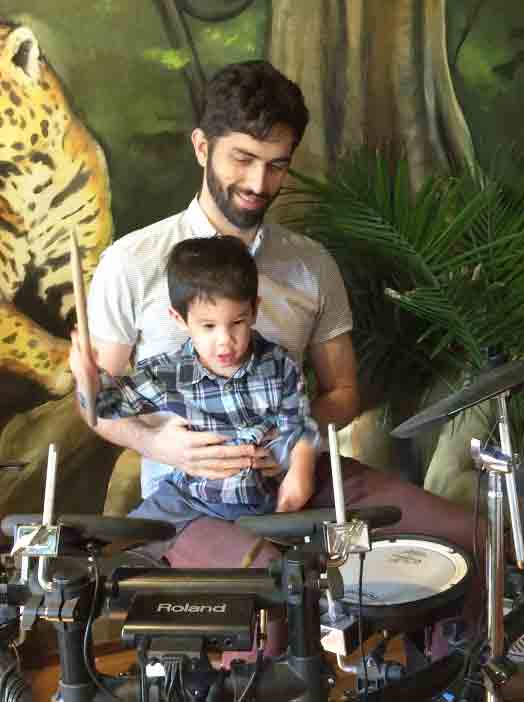Bright Mosaic provides center-based and in-home ABA therapy services in North Texas.
Say goodbye to driving to separate locations for the therapies your child may need. We provide ABA, Speech and Occupational Therapy all in-house, which also allows our therapists in each field to easily collaborate.

What is ABA Therapy?
Applied Behavior Analysis, also known as ABA therapy, is an evidence-based therapy that targets the root causes of behaviors and provides a system of positive reinforcement (rewarding) solutions.
Additionally, ABA therapy is effective in teaching communication, community living and self-help skills, generalization of skills in various settings, and socialization.
As Autism Speaks explains,
“…changes do not typically occur quickly. Rather, most learners require intensive and ongoing instruction that builds on their step-by-step progress. Moreover, the rate of progress – like the goals of intervention – varies considerably from person to person depending on age, level of functioning, family goals and other factors.”
Autism Speaks
Terms to know
Dozens of tools and methodologies are used in the ABA field, and every person on the autism spectrum is unique, so it’s only natural that therapy varies from place to place. There are, however, a few ‘golden standards’ that appear in all ABA programs:
Positive Reinforcement
This is the main economy of ABA therapy. In order to increase the likelihood that a behavior will occur, the instructor will add (positive) something rewarding (reinforcement) right after the behavior is expressed. The most common forms of reinforcement include verbal praise, high fives, and access to preferred items or activities.
Seems like common sense, but knowing how, when, and how much to reinforce – that’s where the science comes in.
Discrete Trial Training (DTT)
Discrete Trial Training (DTT) is a highly structured intervention strategy in which tasks are broken down into small, easier-to-learn components. This is arguably the most commonly used practice in ABA.

Most DTT sessions feature one instructor sitting across a table from one child.
Flash cards, blocks, and other small toys are used for these sessions.
The instructor teaches one component at a time using four steps presented in the following order:
- Instruction given – “touch the blue ball”
- Child Response – correct or incorrect
- Consequence – reward or correction
- Intertrial Interval – 3 to 5 second pause after each trial
Naturalistic Intervention
According to a 2009 evidence-based brief by the National Professional Development Center on Autism Spectrum Disorders at the University of Wisconsin,
“Naturalistic intervention is a collection of practices including environmental arrangement, interaction techniques, and strategies based on ABA therapy principles. These practices encourage specific target behaviors based on learners’ interests by building more complex skills that are naturally reinforcing and appropriate to the interaction.”
National Professional Development Center on Autism Spectrum Disorders at the University of Wisconsin
Simply put, naturalistic intervention offers people on the autism spectrum an opportunity to learn socially appropriate behaviors within the context of their everyday environments– school, the playground, at home, at the grocery store, the library, dining establishments, etc.
For example, let’s pretend there’s a child who’s highly motivated by music and currently working on imitation and following two step instruction goals.

The therapist demonstrates playing the drums and says “do this” (hits snare drum) “then do this” (hits crash cymbal). The child successfully imitates both actions, and the therapist enthusiastically says “good hitting the drum!” and grants the child access to play the drums freely.
From an outsider perspective, this looks like a child and adult having fun with a drum kit, which is true, but they also hit both the imitation and the two step instruction goals along the way.
Programs that focus more on DTTs often look advantageous on short-term progress graphs while naturalistic interventions take a longer period of time to see sustained progress. However, a naturalistic approach to autism intervention is often more beneficial in the long-term for retention, practical skills, and generalization (see below).
Generalization
For such a bland word, it sure means a lot in our field. Generalization is the successful transfer of skills and appropriate behaviors across multiple environments and situations. Some of the best ways to accomplish this include rotating therapists, changing the setting where instruction occurs, and swapping out the materials used during sessions.
What does ABA therapy look like at Bright Mosaic?
Most of the child’s day at Bright Mosaic follows the naturalistic intervention model, incorporating therapy goals into activities that the client naturally prefers and activities that are commonly involved in daily living.
Several times throughout the day, we conduct short DTT sessions as a way to knock out a lot of goals and practice working at a table. After all, much of school and the professional world involves working at a table.
We find this blending of naturalistic intervention and DTT sessions, plus our emphasis on targeting clinic, in-home, and community settings to be the key to unlocking a child’s full potential.
And to be fair, ABA isn’t the only piece of the puzzle. We wouldn’t be the same without Speech Therapy and Occupational Therapy. The three disciplines are most effective when they work together, so we ensure that our therapists from each field share strategies and co-host progress meetings.

Therapy Schedule
The amount of therapy time recommended for each person will depend on their developmental level and the severity of disruptive behaviors.
For someone high-functioning who mainly struggles with social cues and etiquette, perhaps 5 – 10 hours per week is appropriate. For someone who struggles with basic communication and self-help skills, 30 – 40 hours per week is a more likely schedule.
Once the child progresses enough in both skill acquisition and behavior goals, we begin a custom-tailored “fading” process. During fading, the amount of therapy hours gradually decreases and time in public or private school increases.
What are the first steps?
After collecting some basic information and verifying insurance, we begin with the initial assessment.
Initial Assessment
First, our Board Certified Behavior Analysts (BCBA) who supervise our ABA therapy program conduct a thorough initial assessment. The assessment utilizes standardized testing, observation, case history, and medical questionnaires. These tools are effective at measuring:
- Cognition
- Fine and Gross motor abilities
- Speech and social skills
- Typical and atypical behaviors
The on-site portion of the assessment takes about 2 – 4 hours to complete. Parents simply drop their child off at our clinic and we call when it’s time to pick them up.
Medical questionnaires are mostly online, so those, along with gathering case history documents, can be completed from home. Moreover, we provide parents with a list of documents they’ll need and an overview of the enrollment process.
Individualized Treatment Plan
Next, the BCBA analyzes the results of the initial assessment and creates an Individualized Treatment Plan (ITP).
This plan provides a detailed description of behavior deficits and skill acquisition goals, the criteria for each goal’s “mastery,” and the most effective strategies to ensure the child’s progress.
Once the ITP is complete, our BCBAs send parents a copy for review and discussion. The plan gets approved and our highly trained staff go into action. As the child progresses and each ABA therapy goal reaches ‘mastery’ status, new goals take their place and continue laying the groundwork for success.
